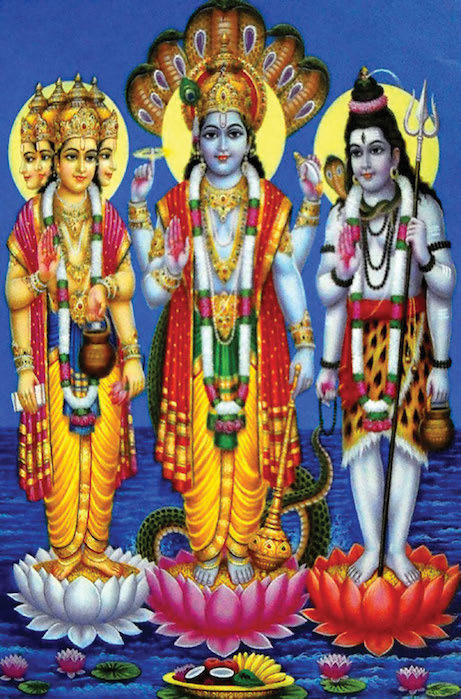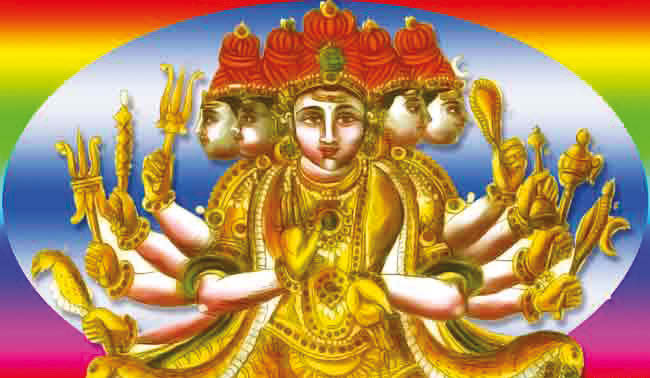
Guru Purnima is an Indian festival dedicated to spiritual and academic teachers. This festival is traditionally celebrated by Hindus, Jains and Buddhists, to pay their respects to their teachers and express their gratitude. The festival is celebrated on the full moon day (Purnima) in the month of Ashadh (June–July) of the Shaka Samvat, which is the Indian national calendar and the Hindu calendar.
Observances
The celebration is marked by ritualistic respect to the guru, Guru Puja. The Guru Principle is said to be a thousand times more active on the day of Gurupurnima than on any other day. The word guru is derived from two words, gu and ru. The Sanskrit root gu means darkness or ignorance, and ru denotes the remover of that darkness. Therefore, a guru is one who removes the darkness of our ignorance. Gurus are believed by many to be the most necessary part of life. On this day, disciples offer puja (worship) or pay respect to their guru (spiritual guide). In addition to having religious importance, this festival has great importance for Indian academics and scholars. Indian academics celebrate this day by thanking their teachers as well as remembering past teachers and scholars.
Traditionally the festival is celebrated by Buddhists in honor of the lord Buddha who gave His first sermon on this day at Sarnath, Uttar Pradesh, India. In the yogic tradition, the day is celebrated as the occasion when Shiva became the first guru, as he began the transmission of yoga to the Saptarishis. Many Hindus celebrate the day in honor of the great sage Vyasa, who is seen as one of the greatest gurus in ancient Hindu traditions and a symbol of the Guru-shishya tradition. Vyasa was not only believed to have been born on this day, but also to have started writing the Brahma Sutras on ashadha sudha padyami, which ends on this day. Their recitations are a dedication to him, and are organised on this day, which is also known as Vyasa Purnima. The festival is common to all spiritual traditions in Hinduism, where it is an expression of gratitude toward the teacher by his/her disciple.[7] Hindu ascetics and wandering monks (sanyasis), observe this day by offering puja to their guru, during the Chaturmas, a four-month period during the rainy season, when they choose seclusion and stay at one chosen place; some also give discourses to the local public.[8] Students of Indian classical music, which also follows the Guru shishya parampara, celebrate this holy festival around the world.
Hindu legend
This was the day, when Krishna-Dwaipayana Vyasa – author of the Mahabharata – was born to sage Parashara and a fisherman’s daughter Satyavati, thus this day is also celebrated as Vyasa Purnima.Veda Vyasa, did yeoman service to the cause of Vedic studies by gathering all the Vedic hymns extant during his times, dividing them into four parts based on their use in the sacrificial rites, and teaching them to his four chief disciples – Paila, Vaisampayana, Jaimini and Sumantu. It was this dividing and editing that earned him the honorific “Vyasa” (vyas = to edit, to divide). “He divided the Veda into four, namely Rig, Yajur, Sama and Atharva. The histories and the Puranas are said to be the fifth Veda.”
Yogic lore
In yogic lore, it is said that Guru Purnima was the day that saw the birth of the Adi Guru, or the first Guru. The story goes that over 15,000 years ago, a yogi[9] appeared in the upper regions of the Himalayas. Nobody knew what his origins were. But his presence was extraordinary, and people gathered. However, he exhibited no signs of life, but for the occasional tears of ecstasy that rolled down his face. People began to drift away, but seven men stayed on. When he opened his eyes, they pleaded with him, wanting to experience whatever was happening to him. He dismissed them, but they persevered. Finally, he gave them a simple preparatory step and closed his eyes again. The seven men began to prepare. Days rolled into weeks, weeks into months, months into years, but the yogi’s attention did not fall upon them again.After 84 years of sadhana, on the summer solstice that marks the advent of Dakshinayana, the earth’s southern run, the yogi looked at them again. They had become shining receptacles, wonderfully receptive. He could not ignore them anymore. On the very next full moon day, the yogi turned south and sat as a guru to these seven men. The Adiyogi (the first yogi) thus became the Adi Guru. Adiyogi expounded these mechanics of life for many years. The seven disciples became celebrated as the Saptarishis and took this knowledge across the world.Guru Purnima is held sacred in the yogic tradition because the Adiyogi opened up the possibility for a human being to evolve consciously. The seven different aspects of yoga that were put in these seven individuals became the foundation for the seven basic forms of yoga, something that has still endured.
Observances by Buddhists and Hindus Buddhists observe on this day uposatha i.e. to observe eight precepts. Vipassana meditators practice meditation on this day under the guidance of their teachers. Rainy season i.e. varsha vassa also starts with this day. During the rainy season lasting for three lunar months from July to October. During this time Buddhist monks remain in a single place, generally in their temples. In some monasteries, monks dedicate the Vassa to intensive meditation. During Vassa, many Buddhist lay people reinvigorate their spiritual training and adopt more ascetic practices, such as giving up meat, alcohol, or smoking.
The Hindu spiritual Gurus are revered on this day by a remembering their life and teachings. Vyasa Puja is held at various temples, where floral offerings and symbolic gifts are given away in his honour and that of the cosmic satguru. The festivities are usually followed by feast for the disciples, shishya, where the prasad and charnamrita literally nectar of the feet, the symbolic wash of Guru’s feet, which represents his grace, kripa is distributed. As a day of remembrance towards all gurus, through whom God grants the grace of knowledge (Jnana) to the disciples,[10] special recitations of the Hindu scriptures especially, the Guru Gita, a 216 verse ode to Guru, authored by the sage, Vyasa himself, are held all day; apart from singing of bhajans, hymns and organising of special kirtan session and havan at many places, where devotees from all over gather at the ashrams, matha or place where the seat of Guru, Guru Gaddi exists.This day also sees the ritual of padapuja, the worships of Guru’s sandals, which represent his holy feet and is seen a way of rededicating to all that a Guru stands for. Disciples also recommit themselves on this day, towards following their teacher’s guidance and teachings, for the coming year. A mantra that is particularly used on this day is “Gurur Brahma, Gurur Vishnu, Gurur Devo Maheshwara, Guru Sakshat Parabrahmah Tasmai Shree Guru Veh Namah”. This day is also seen as an occasion when fellow devotees, Guru Bhai (disciple-brother), express their solidarity to one another in their spiritual journey.





Be the first to comment